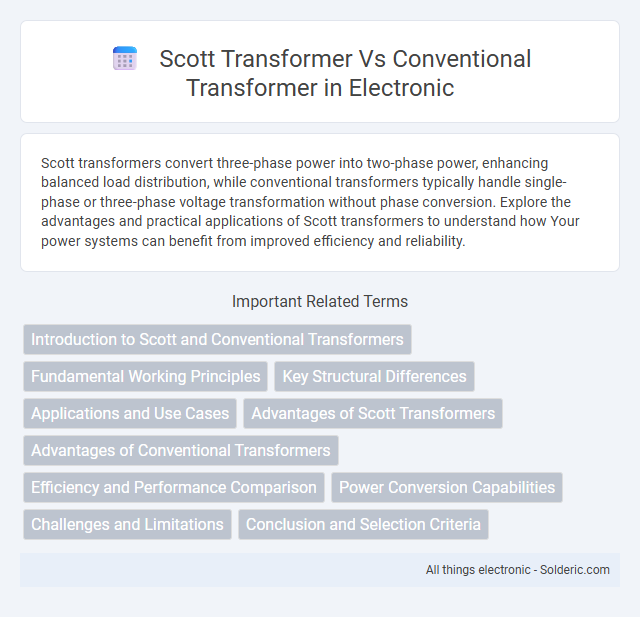Scott transformers convert three-phase power into two-phase power, enhancing balanced load distribution, while conventional transformers typically handle single-phase or three-phase voltage transformation without phase conversion. Explore the advantages and practical applications of Scott transformers to understand how Your power systems can benefit from improved efficiency and reliability.
Comparison Table
| Feature | Scott Transformer | Conventional Transformer |
|---|---|---|
| Architecture | Innovative design optimized for efficiency and scalability | Standard architecture with fixed layer arrangements |
| Performance | Enhanced accuracy on NLP tasks with reduced computation | Reliable, but often requires more resources for similar tasks |
| Scalability | Highly scalable with modular components | Moderate scalability, limited by fixed design |
| Training Speed | Faster convergence due to optimized layers | Slower convergence with standard training methods |
| Use Cases | Advanced NLP, real-time applications, resource-constrained environments | General NLP, machine translation, text generation |
| Resource Consumption | Lower memory and computational requirements | Higher resource consumption due to complexity |
Introduction to Scott and Conventional Transformers
Scott transformers are specialized devices designed to convert three-phase electrical power into two-phase power, enabling compatibility in systems requiring different phase configurations. Conventional transformers primarily serve to change voltage levels within a single phase or three-phase system, using core and coil windings optimized for straightforward voltage transformation. Understanding your power conversion needs helps determine whether a Scott or conventional transformer is suitable for achieving efficient electrical system performance.
Fundamental Working Principles
Scott transformers convert three-phase power into two-phase power using two specially designed single-phase transformers, enabling efficient phase conversion for specific industrial applications. Conventional transformers operate by electromagnetic induction between primary and secondary windings to transfer power within the same phase system, primarily for voltage regulation. Understanding your power needs helps determine whether a Scott or conventional transformer matches your system's requirements.
Key Structural Differences
The Scott transformer features two single-phase transformers with carefully calculated turns ratios to convert a three-phase system into two phases, differing structurally from the iron-core, three-phase conventional transformer. Unlike the conventional transformer's symmetrical winding arrangement, the Scott transformer has a main transformer and a teaser transformer positioned at specific angles to achieve phase shifting. Your choice between these transformers depends on the structural design requirements for efficient phase conversion or standard three-phase voltage transformation.
Applications and Use Cases
Scott transformers are primarily used to convert three-phase power to two-phase power, making them ideal for supplying two-phase loads or testing equipment requiring two-phase input. Conventional transformers are versatile in applications, including voltage step-up/down in power transmission, distribution networks, and general electrical devices. Your choice depends on whether you need specific phase conversion with the Scott transformer or standard voltage transformation with a conventional transformer.
Advantages of Scott Transformers
Scott transformers offer distinct advantages over conventional transformers by enabling the conversion of three-phase electrical power into two-phase power with minimal losses and balanced voltage output. They provide efficient utilization of transformer capacity and enhance power system stability by ensuring phase equilibrium, which is particularly beneficial in applications requiring two-phase power. Your electrical system benefits from improved load balancing and reduced risk of overloading, making Scott transformers ideal for specialized industrial processes and legacy equipment compatibility.
Advantages of Conventional Transformers
Conventional transformers offer advantages such as simplicity in design, cost-effectiveness, and proven reliability for a wide range of voltage levels and applications. Their straightforward construction allows for easy maintenance and replacement of parts, which reduces downtime and operational costs. Additionally, conventional transformers provide high efficiency and stable performance under varying load conditions, making them suitable for general power distribution tasks.
Efficiency and Performance Comparison
Scott transformers provide improved efficiency by enabling precise voltage transformation and balanced load distribution in two-phase systems, reducing energy losses compared to conventional transformers. Conventional transformers typically experience higher core and copper losses due to their single-phase design, making them less efficient in certain applications that require phase conversion. Your choice of transformer impacts overall system performance, with Scott transformers offering enhanced voltage regulation and better utilization of electrical power in specialized industrial settings.
Power Conversion Capabilities
Scott transformers enable effective power conversion by transforming three-phase power into two-phase power and vice versa, optimizing load balancing in systems with unbalanced or single-phase loads. Conventional transformers primarily handle single-phase or three-phase power conversion without phase shifting capabilities, limiting their flexibility in specific applications. The Scott transformer's unique ability to maintain voltage and phase stability enhances power quality and improves the efficiency of electrical distribution networks.
Challenges and Limitations
Scott transformers present challenges in phase shifting accuracy and handling unbalanced loads, limiting their effectiveness in power system applications compared to conventional transformers. Conventional transformers, while more robust in load capacity and voltage regulation, often face limitations in achieving efficient phase angle conversions and require complex configurations for phase displacement. Both types encounter issues related to size, cost, and maintenance, but Scott transformers specifically struggle with narrow application scope and lower fault tolerance in three-phase systems.
Conclusion and Selection Criteria
Scott transformers provide efficient phase conversion from three-phase to two-phase power, essential for specific industrial applications requiring balanced loads. Conventional transformers excel in general-purpose voltage transformation with higher system compatibility and ease of maintenance. Selection depends on application requirements: choose Scott transformers for phase conversion needs and conventional transformers for standard voltage transformation and widespread use.
Scott transformer vs conventional transformer Infographic

 solderic.com
solderic.com